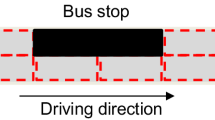Abstract
This article studied bus signal priority (BSP) strategies at road intersections containing bus lane through simulation. Based on cellular automata (CA) theory, the coordination of single-phase buses and cars under different BSP control strategies is studied and the “speed-distance” condition is introduced in transit signal priority, with which two indicators for evaluation considered resource constraints are proposed, namely, fuel consumption and exhaust emissions. The effect on the consumption of general vehicles from bus signal priority is shown by CA simulation, and the judgment of the bus priority level is determined by the calculation of fuel consumption and exhaust emissions.
Access this chapter
Tax calculation will be finalised at checkout
Purchases are for personal use only
Similar content being viewed by others
References
Elias, Wilbur J (1976) The Greenback experiment-signal pre-emption for express buses: a demonstration project. California Department of Transportation, Sacramento, Report DMT-014
Ludwick JS (1976) Bus priority system: simulation and analysis. Final Report, the Mitre Corporation. Prepared for the U.S Department of Transportation, Report No.UTAVA-06-0026-1
Kui-hong G (2010) Research on bus priority signal coordination control and simulation in urban road intersections. Beijing Jiaotong University, Beijing (in Chinese)
Casey et al (1991) Advanced public transportation system: the state of the art, U. S. Department of Transportation Urban Mass Transportation Administration, Component of Department IVHS Initiative, Apr 1991
Jepson D, Ferrira L (2000) Assessing travel time impacts of measures to enhance bus operation. Part 2: study methodology and mainfindings. Road Transp Res 9(1):4–l9
Ngan N, Sayed T, Abdelfatah A (2004) Impacts of various traffic parameters on transit signal priority effectiveness. J Public Transp (S1077-291X) 7(3):71–93
Shen-pei Z (2009) Reaserch on traffic signal control strategies in urban intersections based on emission factors. Wuhan University of Technology, Wuhan (in Chinese)
Qiao-jun X (2000) Research on vehicle fuel consumption in the urban transportation system. Southeast University, Nanjing (in Chinese)
Bin J, Zi-you G, Ke-ping L et al (2007) Models and simulations of traffic system based on the theory of cellular automaton. Science Press, Beijing (in Chinese)
Lei Z (2010) Research of microscopic traffic simulation based on cellular automata and fuzzy control. Southwest Jiaotong University, Chengdu (in Chinese)
Acknowledgments
This study is supported by the Young Scientists Fund of the National Natural Science Foundation of China (71101008), the Key Project of Chinese National Programs for Fundamental Research and Development (973 program) (2012CB725403) and the Fundamental Research Funds for the Central Universities (2012JBM057) and the China Scholarship Fund.
Author information
Authors and Affiliations
Corresponding author
Editor information
Editors and Affiliations
Rights and permissions
Copyright information
© 2014 Springer-Verlag Berlin Heidelberg
About this paper
Cite this paper
Wei, L., Zhang, L., Wang, Z. (2014). A Cellular Automata Model on Bus Signal Priority Strategies Considering Resource Constraints. In: Wen, Z., Li, T. (eds) Practical Applications of Intelligent Systems. Advances in Intelligent Systems and Computing, vol 279. Springer, Berlin, Heidelberg. https://doi.org/10.1007/978-3-642-54927-4_65
Download citation
DOI: https://doi.org/10.1007/978-3-642-54927-4_65
Published:
Publisher Name: Springer, Berlin, Heidelberg
Print ISBN: 978-3-642-54926-7
Online ISBN: 978-3-642-54927-4
eBook Packages: EngineeringEngineering (R0)




